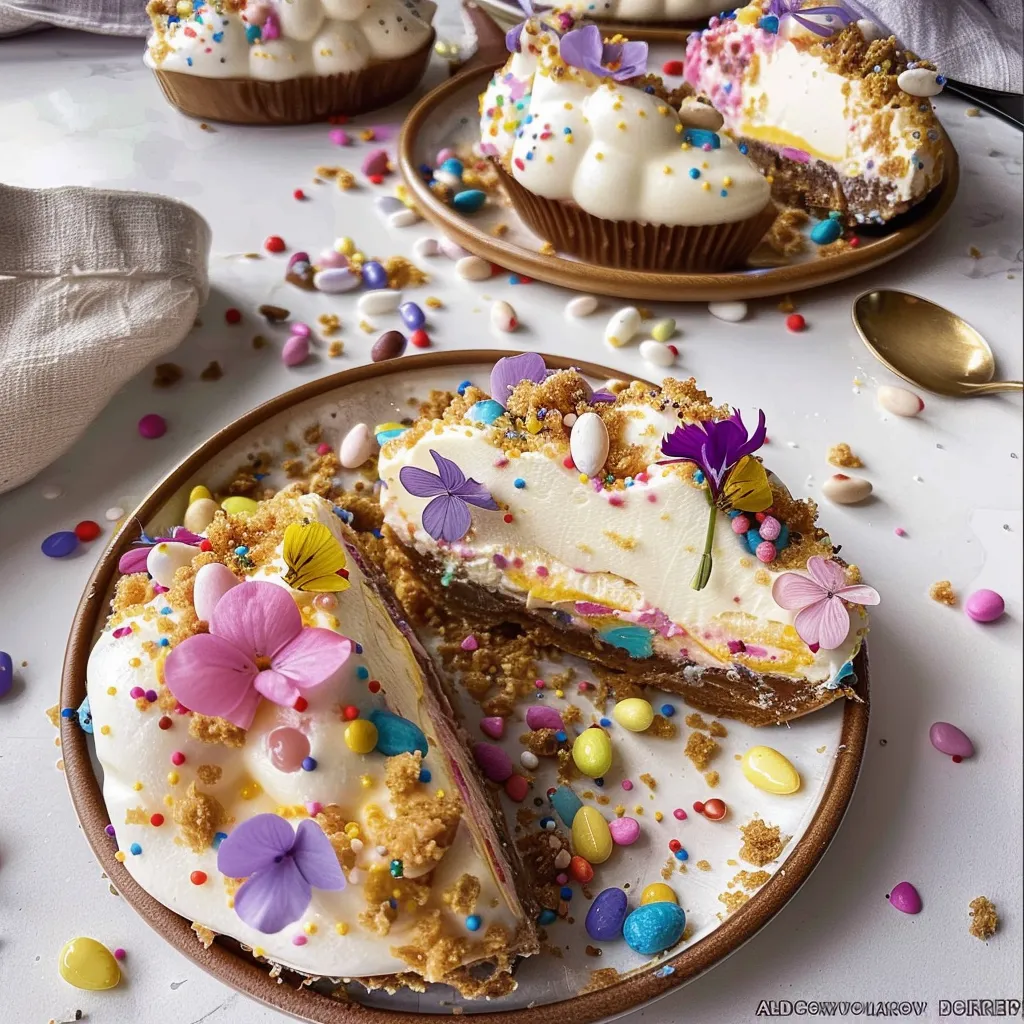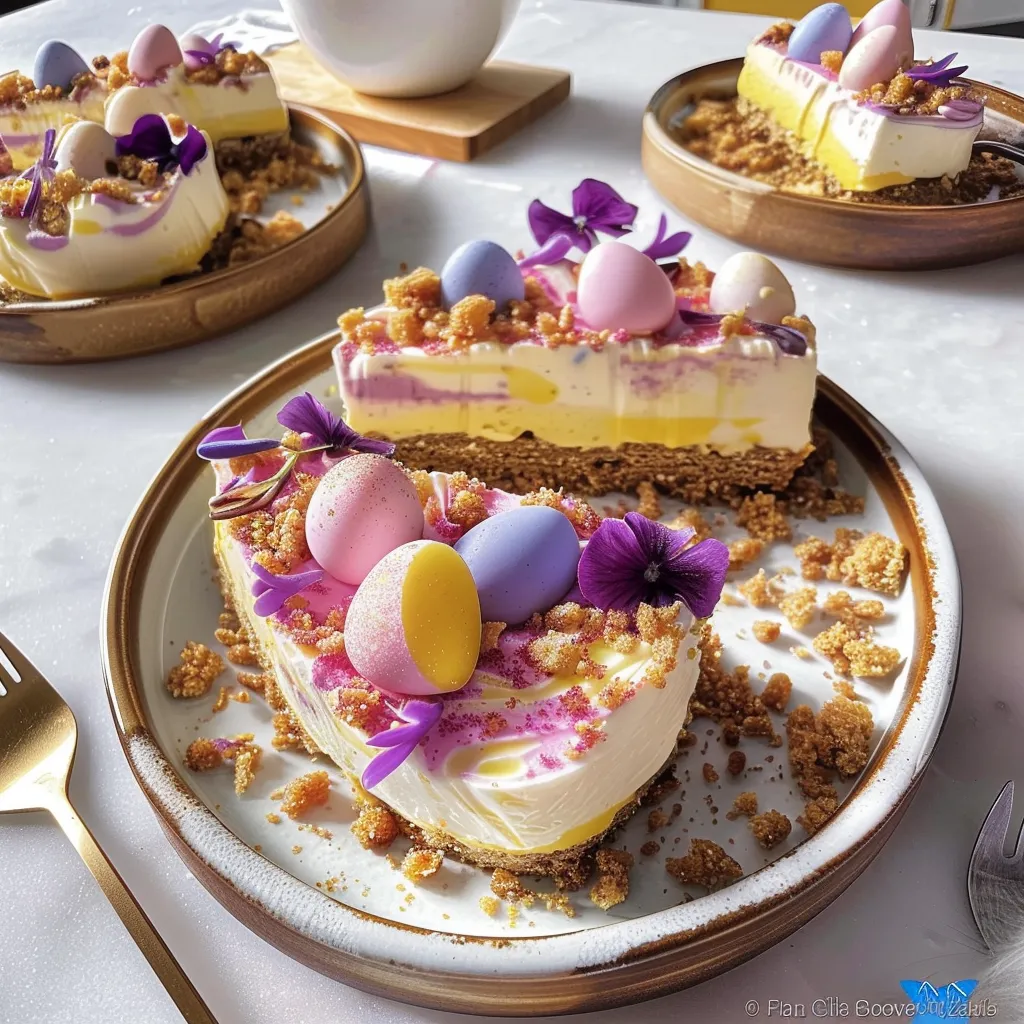Easter Egg Cheesecake: A Decadent Spring Dessert

Are you ready to elevate your spring celebrations with a decadent dessert that captures the essence of Easter? The delightful Easter Egg Cheesecake is not just a treat for your taste buds; it’s a showstopper that will dazzle your family and friends. With its creamy, velvety texture and rich flavors, this cheesecake brings together the joys of the holiday season and the indulgence of dessert.
What’s even more exciting is the potential for creativity! You can easily swap traditional ingredients for a unique twist—consider using crushed cookies for the crust or incorporating your favorite chocolate candies within the filling. For added flair, top your cheesecake with colorful chocolate eggs or a drizzle of fruit compote to celebrate the vibrant spirit of Easter.
To achieve the ideal result, remember to let your cheesecake cool gradually after baking, ensuring a smooth texture without cracks. With these tips and variations, your Easter gathering is sure to be one for the books!
Ingredients for Easter Egg Cheesecake:
This delightful dessert is perfect for celebrating the Easter holiday, combining the rich flavors of cheesecake with the festive charm of Easter eggs. Below is a detailed list of ingredients required to create a scrumptious cheesecake serving 8-10 people.
For the Crust:
- 1 ½ cups graham cracker crumbs (about 12 full graham crackers, finely crushed)
- ⅓ cup granulated sugar
- ½ cup unsalted butter, melted
- 1 teaspoon vanilla extract
For the Cheesecake Filling:
- 3 (8-ounce) packages of cream cheese, softened to room temperature
- 1 cup granulated sugar
- 1 teaspoon vanilla extract
- 3 large eggs, at room temperature
- 1 cup sour cream
- 1 cup heavy whipping cream
- ½ cup mini chocolate eggs, coarsely chopped (or other chocolate Easter eggs, if preferred)
For the Topping:
- 1 cup whipped topping (store-bought or homemade)
- ½ cup crushed candy-coated chocolate eggs (for garnish)
- Chocolate syrup (optional, for drizzling)
Flavor Variations:
Consider experimenting with different flavors to make your cheesecake unique:
- Chocolate Lover’s Easter Cheesecake: Incorporate ½ cup of cocoa powder into the filling for a luscious chocolate base.
- Fruit-Tastic Cheesecake: Add 1 cup of pureed berries or citrus zest to the filling to create a fruity twist.
- Nutty Crunch Cheesecake: Use crushed cookies or nuts for the crust to introduce a delightful crunch.
Feel free to mix and match ingredients to create your own personalized version of this festive dessert. Enjoy making memories while preparing this delightful cake with your loved ones!

How to prepare Easter Egg Cheesecake:
Creating a delicious Easter Egg Cheesecake involves several clear steps. Let’s break it down for easy understanding.
Step 1: Gather Your Ingredients
Start by collecting all necessary ingredients. You will need cream cheese, sugar, vanilla extract, sour cream, eggs, and crushed Easter chocolate eggs. Don’t forget the graham cracker crumbs and butter for your crust!
Step 2: Prepare the Crust
In a medium bowl, mix 1 ½ cups of crushed graham cracker crumbs with ½ cup of melted butter. Stir until the mixture feels like damp sand.
Press the crumb mixture evenly into the bottom of a 9-inch springform pan. Use the back of a measuring cup to pack it tightly.
Step 3: Bake the Crust
Preheat your oven to 350°F (175°C). Place the springform pan with the crust into the oven.
Bake for about 8-10 minutes, or until the crust is lightly golden. Remove it from the oven and allow it to cool completely. This step is crucial for firmness.
Step 4: Prepare the Cheesecake Filling
In a large bowl, beat 4 packages (8 ounces each) of softened cream cheese until smooth. This process generally takes about 2-3 minutes.
Add 1 cup of granulated sugar and 1 teaspoon of vanilla extract to the cream cheese. Mix until well combined.
Step 5: Incorporate Eggs
Crack in 4 large eggs, one at a time. Ensure each egg is fully incorporated before adding the next. This will help avoid lumps in your cheesecake.
Step 6: Add Sour Cream
Gently fold in 1 cup of sour cream. The sour cream adds creaminess and elevates the flavor of your cheesecake.
Step 7: Mix in the Easter Chocolates
Finally, fold in 1 cup of crushed Easter chocolate eggs into the batter. This will create delightful chocolate surprises in each bite!
Step 8: Bake the Cheesecake
Pour the cheesecake batter over the cooled crust in the springform pan. Bake in a preheated oven at 325°F (160°C) for 55-60 minutes.
Check for doneness by gently shaking the pan; the center should be slightly jiggly.
Step 9: Cool and Chill
Turn off the oven and crack the door, letting the cheesecake cool gradually for an hour. After that, refrigerate it for at least 4 hours, preferably overnight.
Step 10: Serve and Enjoy
Once chilled, carefully remove the sides of the springform pan. Slice the cheesecake and serve it chilled. Enjoy your delightful creation!
Tips for the Perfect Easter Egg Cheesecake
Maintain the Correct Temperature
To achieve a smooth and creamy texture, start by letting your cream cheese come to room temperature. Cold cream cheese can lead to lumps in your batter. Typically, this takes about 30 minutes. Additionally, when mixing, use a low speed to avoid incorporating too much air, which can make your cheesecake rise and crack during baking.
Use Quality Ingredients
The quality of your ingredients plays a crucial role in the final flavor. For the best results, opt for full-fat cream cheese, as it provides a rich and decadent base. Real vanilla extract adds depth, while fresh eggs contribute to the overall creaminess of your dessert. Using high-quality Easter eggs for decoration not only enhances the visual appeal but also adds a delightful flavor twist. Look for chocolate with a high cocoa content to ensure a rich taste.
Perfecting the Crust
A solid crust supports your cheesecake brilliantly. For a traditional crust, try using digestive biscuits or graham crackers combined with melted butter. If you’re looking for a gluten-free option, substitute with almond flour mixed with coconut oil. Feel free to experiment with flavors by adding a pinch of cinnamon or cocoa powder to your crust mixture.
Substitutions for Dietary Restrictions
If you’re catering to lactose intolerance, use lactose-free cream cheese and Greek yogurt as a substitute for sour cream. For a vegan version, craft a cheesecake using blended tofu, coconut cream, and a vegan cream cheese alternative. Adjust the sweetener based on your preference, using maple syrup or agave for a plant-based option.
Chilling Your Cake
Cooling is a vital step. After baking, let your cheesecake cool in the pan for at least 15 minutes before transferring it to the refrigerator. Cover with plastic wrap or foil to prevent the formation of a crust. Refrigerate for a minimum of four hours, preferably overnight, to allow the flavors to meld beautifully.
Garnishing Your Cheesecake
Finally, finish with flair! Decorate with your choice of Easter egg candies, whipped cream, or a drizzle of chocolate sauce. For a fresh touch, consider adding berries or mint leaves. These additions not only enhance the look but also provide a delightful contrast to the rich cheesecake.
By following these helpful tips, you can ensure a delightful and memorable dessert fit for any Easter celebration!
Storage Tips for Easter Egg Cheesecake:
Maintaining the freshness of your Easter Egg cheesecake is crucial for enjoying its delightful flavor and creamy texture. Follow these practical storage tips to keep your dessert tasting great.
Optimal Storage Conditions for Cheesecake
Store your cheesecake in the refrigerator as soon as it cools down after baking. Wrap it tightly with plastic wrap to prevent it from absorbing any odors. You can also place it in an airtight container for added protection. Make sure the cheesecake is completely chilled before wrapping to avoid condensation, which can affect its texture. Keep the cheesecake on a flat shelf in the fridge and avoid placing it in the fridge door, where temperatures can fluctuate.
Best Practices for Freezing
If you want to extend the shelf life of your cheesecake, consider freezing it. First, let the cheesecake cool completely. Then, cut it into individual slices for easy serving later. Wrap each slice tightly in plastic wrap, ensuring no air pockets remain. Place the wrapped slices into a sturdy freezer-safe container or a resealable plastic bag. Label the bag with the date to keep track of how long the cheesecake has been frozen.
Understanding Shelf Life
A homemade Easter Egg cheesecake lasts about 5 to 7 days in the refrigerator. If you store it properly in the freezer, it can maintain its quality for up to 2 to 3 months. However, for the best taste and texture, aim to consume it within the first month after freezing.
Thawing Your Cheesecake
When you’re ready to enjoy a slice from the freezer, remove it and place it in the refrigerator for a slow thaw. Allow about 4 to 6 hours for slices to thaw completely. Avoid thawing the cheesecake in the microwave, as this may alter the texture and disrupt the creamy flavor. After thawing, enjoy the cheesecake within 2 to 3 days to ensure its taste remains delightful.
Following these storage tips will help you maintain the deliciousness of your Easter Egg cheesecake, allowing you to savor it long after your holiday celebrations. Enjoy every creamy bite!
Related Recipes for Your Easter Feast
If you love the rich, creamy delight of an Easter Egg Cheesecake, you’ll enjoy these related recipes that offer similar flavors or complement your dessert beautifully.
First, consider a Chocolate Cream Pie. This pie features a smooth chocolate filling, perfect for chocolate lovers. It brings a luscious texture and a rich taste that pairs well with a cheesecake. The chocolate filling and the crispy crust provide a different but similar indulgence, offering a delightful contrast to the creaminess of the cheesecake.
Next, try Carrot Cake with Cream Cheese Frosting. This classic cake has spices and sweetness that echo the festive spirit of Easter. The cream cheese frosting adds a tart touch, balancing the sweetness. The texture of the cake is light yet moist, making it a delightful counterpart to the denser cheesecake while keeping a seasonal vibe.
Another excellent choice is Mini Egg Brownies. These brownies incorporate crunchy mini chocolate eggs for a festive twist. The contrast between the fudgy brownie base and the crunchy candy creates a delightful experience. They make for an easy, shareable treat and serve as a decadent option to enjoy after the cheesecake.
Also, don’t overlook Lemon Meringue Pie. Its tangy filling and fluffy meringue provide a refreshing balance to the richer desserts. The bright lemon flavor can cleanse the palate after a heavy meal, ensuring a well-rounded dessert table.
Explore these recipes to create an Easter spread that draws on the flavors and joy of the season! Each dish complements the cheesecake perfectly, making your celebration even sweeter.
Frequently Asked Questions:
What is Easter Egg Cheesecake?
Easter Egg Cheesecake is a delightful dessert that combines the rich creaminess of traditional cheesecake with the festive flavors and decorations associated with Easter. This dessert often incorporates chocolate Easter eggs or other seasonal candies, making it a sweet treat that is visually appealing and perfect for holiday gatherings.
Can I use any type of cream cheese for this recipe?
Yes, you can use regular or reduced-fat cream cheese for your cheesecake. However, it’s advisable to choose a block cream cheese instead of spreadable varieties to ensure a firmer texture. This keeps the cheesecake from becoming too soft and helps maintain its structure, especially when it includes such festive elements.
How do I prevent my Easter themed cheesecake from cracking?
To prevent cracks in your cheesecake, maintaining a consistent baking temperature is crucial. Additionally, ensuring that your ingredients, particularly the cream cheese, are at room temperature before mixing can promote even blending, resulting in a smoother batter. Using a water bath during baking can also help regulate heat.
What toppings can I use for my festive cheesecake?
When decorating your Easter-inspired cheesecake, creativity is key! Consider using whipped cream, colorful sprinkles, or crushed chocolate eggs to add texture and color. Fresh fruit like berries can also provide a fresh contrast to the rich flavors, enhancing both the appearance and taste of this delectable dessert.
Can I make this cheesecake ahead of time?
Absolutely, an Easter Egg Cheesecake can be made in advance! In fact, allowing it to chill overnight in the refrigerator enhances the flavors and texture. Just remember to save any toppings or decorative elements for the day you plan to serve it, ensuring they remain fresh and visually attractive.
Is it possible to make a gluten-free version of this cheesecake?
Yes, making a gluten-free version of this festive cheesecake is totally feasible! Simply substitute the typical graham cracker crust with crushed gluten-free cookies or a nut-based crust. Make sure to check the labels on any add-ins like chocolate eggs and candies to confirm they are gluten-free for a worry-free dessert.
Conclusion:
The Easter Egg Cheesecake is a deliciously simple dessert that effortlessly celebrates the spirit of the season. With its creamy texture and rich flavors, this cheesecake stands out as an alluring centerpiece for your Easter festivities. The beauty of this recipe lies in its flexibility; you can adapt the crust and filling to suit your preferences, whether you prefer a traditional graham cracker crust or a more innovative option. Additionally, customization options are abundant—feel free to mix in your favorite chocolates, fruits, or flavor extracts to create a personal touch. Remember, the key to a delightful cheesecake is not just in the ingredients but also in the love and creativity you pour into it. So, gather your loved ones, unleash your inner chef, and enjoy crafting this crowd-pleasing dessert that will leave everyone asking for seconds!
